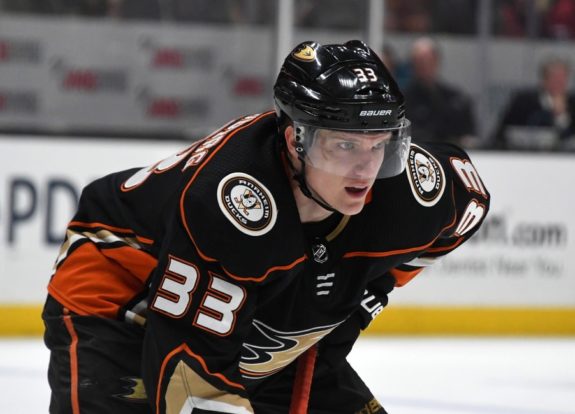It’s been almost a year since Anaheim Ducks general manager Bob Murray traded puck-moving defenseman Sami Vatanen to the New Jersey Devils for center Adam Henrique. That trade helped the Ducks shake off a spate of injuries and qualify for the playoffs for a sixth consecutive season. This year, Anaheim finds themselves in a similar situation, but those hoping Bob Murray will pull the trigger on a trade that will make the Ducks contenders should change their attitude. Any trades Murray makes should be done with an eye toward rebuilding.
The Ducks Window Has Slammed Shut
It’s been a long period of success for the Ducks, missing the playoffs only three times in 15 seasons. The window that was opened by the emergence of Corey Perry and Ryan Getzlaf is finally sliding shut. Even if they’re only one point worse than they were through 23 games last season, and are now third in the Pacific Division, the eye test is enough to see its time for a new era in Ducks hockey.
Anaheim dealt with injury issues last season but when comparing the analytics, the team’s performance has fallen off the same cliff its veterans have. Just three seasons ago, the Ducks were at a 52.3 Corsi For percentage. Now they have a dismal 44.2 percent during 5-on-5 play, which is actually an improvement from earlier in the season.
That puck possession disparity has resulted in the Ducks sitting at the bottom of the league in goals for, even after a four-goal outburst in Wednesday’s 4-3 win over the Vancouver Canucks. They are on pace for 178 goals, which is 35 goals worse than this point last season when they scored the fewest goals of any playoff-bound team. I don’t think anyone needs reminding how that went for the Ducks.
Last season’s performance had them out of the playoff picture as late as mid-March and Henrique’s contributions both offensively and on special teams made the difference between missing and making the playoffs.

That is not the case this season. The team needs far more than contributions from one player to make up for the deficiencies in their game.
Murray and the Ducks Should Start Selling
Just because one trade didn’t fix the team’s issues doesn’t mean the Ducks should stay out of the market. Murray should be open to the idea of accepting offers for many of his well-established players at this point, but as Eric Stephens mentioned in his most recent article in The Athletic, management hasn’t embraced that position:
“Should the Ducks start seeing themselves as sellers? They’re most certainly not taking that view in the team’s offices, not with a ho-hum Pacific Division that’s allowed them to keep breathing and a general manager who treats the word “rebuilding” as if it’s a rash. But there are those watching on a nightly basis who wouldn’t mind them embracing a yard sale right now,” (from ‘Which Ducks are most likely to be traded?’, The AthleticNHL – 11/19/18).
It should be obvious to Murray that giving up assets geared toward making the Ducks contenders again this season would be like trying to bail out a sinking ship with a soup spoon. Even if Anaheim landed William Nylander, the price they’d have to pay for him would likely include one of their puck-moving defensemen and the same prospects the Ducks are relying on to keep their team afloat, especially now that Hampus Lindholm and Cam Fowler are among the wounded. Not only that, the Ducks would still have to pay Nylander, who’s looking for no less than $8 million per year.
Ducks’ Salary Cap Headache
Don’t forget about the salary cap. If the Ducks took on Nylander and whatever new contract he might accept, he would be on the books this season which is difficult considering the team’s salary cap situation. They would have to rid themselves of multiple big contracts to make room for him because once Perry returns from long-term injured reserve, so does the money he’s owed.
RELATED: View the Complete Ducks Salary Cap Numbers
Ducks Need to Delay Gratification
This is not a cry for the team to sell of everyone — they couldn’t even if they wanted to — but there are players that are appealing as rentals who the Ducks could use to accumulate young assets. Jakob Silfverberg is a prime example. He enters free agency after this season and his scoring ability combined with his defensive responsibility make him an attractive target for a contending team.

As Stephens mentions in his article, surprisingly, Adam Henrique could be another:
Henrique’s extension doesn’t kick in until next season and, more important, his 10-team no-trade doesn’t activate until July. He could make a team much deeper down the middle, but it also would have to bet that the heady forward’s best days aren’t behind him, (from ‘Which Ducks are most likely to be traded?’, The AthleticNHL – 11/19/18).
Since the Ducks are probably stuck with Kesler until 2021-22 and Perry until 2020-21, why not surround them with younger faster players acquired through trades and the draft. It seems that the Ducks have already fallen out of Stanley Cup contention and now would be an excellent time to continue to develop the next generation of Ducks players utilizing the expertise of veterans they can’t manage to offload. Who better to learn from than Perry, Getzlaf and Kesler?
Also, let’s not forget that by 2022, when the Ducks no longer owe Getzlaf, Perry and Kesler so much money, a number of attractive UFAs may be on the market, including Johnny Gaudreau, Filip Forsberg, Seth Jones and Tomas Hertl among others. If Anaheim’s front office still shows a knack for drafting and development, one of these players may be the final piece.